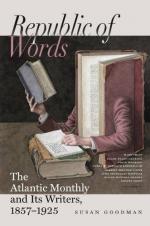Let us make the most common application of it to natural objects. Suppose we see together a Dog, a Cat, a Bear, a Horse, a Cow, and a Deer. The first feature that strikes us as common to any two of them is the horn in the Cow and Deer. But how shall we associate either of the others with these? We examine the teeth, and find those of the Dog, the Cat, and the Bear sharp and cutting, while those of the Cow, the Deer, and the Horse have flat surfaces, adapted to grinding and chewing, rather than cutting and tearing. We compare these features of their structure with the habits of these animals, and find that the first are carnivorous, that they seize and tear their prey, while the others are herbivorous or grazing animals, living only on vegetable substances, which they chew and grind. We compare farther the Horse and Cow, and find that the Horse has front teeth both in the upper and lower jaw, while the Cow has them only in the lower; and going still farther and comparing the internal with the external features, we find this arrangement of the teeth in direct relation to the different structure of the stomach in the two animals,—the Cow having a stomach with four pouches, adapted to a mode of digestion by which the food is prepared for the second mastication, while the Horse has a simple stomach. Comparing the Cow and the Deer, we find that the digestive apparatus is the same in both; but though they both have horns, in the Cow the horn is hollow, and remains through life firmly attached to the bone, while in the Deer it is solid and is shed every year. With these facts before us, we cannot hesitate to place the Dog, the Cat, and the Bear in one division, as carnivorous animals, and the other three in another division as herbivorous animals,—and looking a little farther, we perceive, that, in common with the Cow and the Deer, the Goat and the Sheep have cloven feet, and that they are all ruminants, while the Horse has a single hoof, does not ruminate, and must therefore be separated from them, even though, like them, he is herbivorous.
This is but the simplest illustration, taken from the most familiar objects, of this comparative method; but the same process is equally applicable to the most intricate problems in animal structures, and will give us the clue to all true affinities between animals. The education of a naturalist, now, consists chiefly in learning how to compare. If he have any power of generalization, when he has collected his facts, this habit of mental comparison will lead him up to principles, to the great laws of combination. It must not discourage us, that the process is a slow and laborious one, and the results of one lifetime after all very small. It might seem invidious, were I to show here how small is the sum total of the work accomplished even by the great exceptional men, whose names are known throughout the civilized world. But I may at least be permitted to speak of my own efforts, and to sum up in the fewest words




